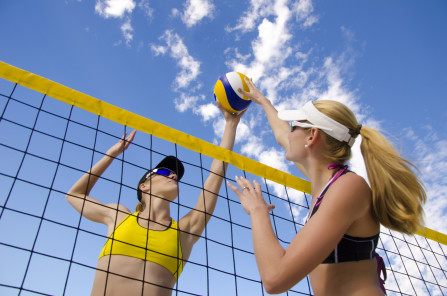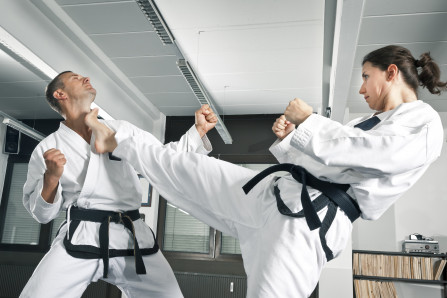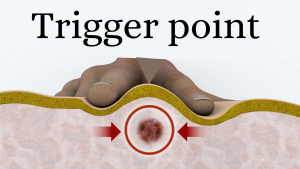Does massage help athletic or sports performance: with practical advice
Professional sports clubs have long used massage as a way to help their athletes, and more recently various self massage options have... Read Article

Most articles on sports reaction times will advise you that your reaction times are influenced by things such as training, sleep, gender and medical conditions. The reality is that these only have a small effect, if any, and are not something you can significantly improve. However, there are two things that do have a significant impact on your reaction times that you can do something about.
In this article we will give you an overview of reaction times and details of those two ways to improve.
Overview of reaction times
The two things that can improve your reaction times
References
Your reaction time is simply the time taken between a stimulus and when you take action. There are two parts to this we need to consider.
In this section:
Your physiological reaction time is the time taken between when your brain recognises the need to act and when your muscles start to contract. It is divided into two parts: pre-motor and motor.
Despite differences in sports performances the physiological reaction time is very similar for most people, averaging about 200 ms. A "ms" is 1/1000 of a second, making this time about 1/5 of a second (1).
Despite the advice often given research shows that training cannot change this speed of approximately 200 ms (2–4).
This reaction time is similar whether you are male or female, and will not deteriorate if you do not get enough sleep (1).
This reaction time slows down 5-10 ms after exercising, presumably due to fatigue of the parts involved (5).
Anticipation time is the time taken between a stimulus occuring and your brain interpreting that it needs to react.

Most research on reaction times is done with people reacting to stimuli such as lights or sound. With these ones brain will instantly recognise the need to react. However, in one trial karate practitioners were required to react to a threat on a video (3). When comparing advanced practitioners to novices the physiological reaction times were the same, but the advanced practitioners were able to perceive the need to react 100 ms faster. They would be able to do this by improved situational awareness and the ability to better interpret visual cues.
Therefore, in practice the time taken to react includes both anticipation and the physiological reaction time. The nerves and muscles of higher level sports people work at about the same speed as novices, but higher level sports people are able to anticipate and make a decision to react much faster.
The big difference between novice and higher level athletes is that the high level athletes have faster reactions due to a shorter anticipation time.
As the karate example showed, experienced practitioners were able to interpret the situation and the need to react 100 ms faster. This is where practice and appropriate training can make a big difference.
In the trials that have been done we can assume that those tested were generally alert and waiting for the stimulus such as a light or a sound. On the other hand someone playing sport could be tired or not concentrating, delaying a reaction considerably. This is one area where things such as the following will help.
(Myofascial) trigger points, or trigger points for short are those tender lumps in your muscles that therapists find. These are very common in the muscles of sports people, and have been found to inhibit the function of muscles. In a trial comparing muscles with and without trigger points those with trigger points were found to react up to 100 ms slower (6).

The researchers found that the time taken for the nerves to deliver the messages remained unchanged, but the trigger points caused a delay of up to 100 ms in the time taken from when the muscle to receives the signal to when it contracts.
The karate trial found that the difference between an experienced practitioner and a novice was that with the novices there was a delay of 100 ms in perceiving the need to react. This can be the difference between being able to block a kick or punch, and being knocked out. The researchers found that trigger points can cause a similar 100 ms delay.

A typical ground shot in tennis travels at about 100 kph, which is 28 meters per second. Therefore, during a 100 ms delay due to trigger points the tennis ball would travel 2.8m. In other words, due to the trigger point the tennis ball will have traveled an extra 2.8m before your racket got there.
In the simple example above the tennis player with the trigger points would just be missing or miss-timing the shot. In reality these movements require the coordinated effort of many muscles, and some may have trigger points while others may not (7,8).
As a simple example, say we have a movement that need two muscles to contract together, but one had a trigger point while the other did not. Your brain would send out messages to both at the same time, but the muscle with the trigger point would contract 100 ms later. The reality is with many muscles it is more complicated, but this illustrates the principle of how timing and biomechanics can be affected. As an example this can be a major cause of shoulder pain (see Why shoulder pain keeps coming back and what you can do about it ).
Trigger points are extremely common. As an example, one trial found that nearly 90% of adults with no pain had trigger points in their shoulder muscles alone (9). While they are best known for causing pain, as this article discusses even when not causing pain they can have serious effects. Also, unfortunately as discussed in our article What is the best treatment for trigger points , trigger points are generally under-diagnosed and poorly treated. However, the following guides will share with you an easy effective way you can find and treat these trigger points yourself.
Your Complete Guide To (Myofascial) Trigger Points
The simple effective way to treat trigger points yourself
Video: How to treat trigger points
We are continually adding more information on research and uses. Subscribe below to have us email them to you "hot off the press".

Several years ago Dr Graeme, a Chiropractor practicing in Victoria, Australia was looking for a serious hand held massager his patients could use at home to get the extra quality massage they needed. The ones he found in the shops and on-line for home use looked nice but were not serious, and... read more
Professional sports clubs have long used massage as a way to help their athletes, and more recently various self massage options have... Read Article
It is claimed that sports massages helps with recovery after sports or exercise, but do they, and are they worth getting? When we looked... Read Article
As practitioners we are continually dealing with dysfunctional musculoskeletal systems. Typically dysfunction develops and is perpetuated... Read Article
Treating or releasing trigger points yourself is actually extremely easy. With a bit of instruction and practice you can easily find the... Read Article
Tennis elbow is a painful condition where prolonged abnormal tension in your forearm muscles causes the site where they are attached to... Read Article
Most articles on sports reaction times will advise you that your reaction times are influenced by things such as training, sleep, gender... Read Article
Massage or “pressure point” therapy has given excellent relief of headaches in clinical trials. In this article we will show you how to... Read Article
Massage has been widely used by sports clubs and professional athletes, but more recently self massage options have made these more... Read Article
Hand held massagers have allowed us to have massages without the expense and appointments needed when using a professional therapist. ... Read Article
Do not refresh or leave this page until loading complete.